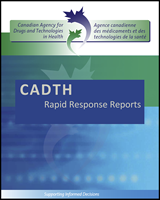What is the clinical effectiveness of NG feeding tubes compared with PEG for patients with head or neck cancer?
The AMSTAR quality assessment tool for SRs16 was used to assess SR quality and scores were assigned (Table 6 in Appendix 2). All SRs were based on extensive and well documented literature searches. All SRs employed at least two independent data extractors. Despite these efforts, the evidence base is limited as there have been very few RCTs. For example, one RCT of 33 randomized patients25 was included in the recent Cochrane review,1 the RCT being switched to a prospective non-randomized study as few patients would consider randomization12 and two others were included in an SR from the Netherlands (although these were considered by the Cochrane reviewers and ultimately did not meet their inclusion criteria).18 The other two SRs included more studies but these were of less rigorous designs.9,19 Of these two SRs, the earlier review19 commented that the available studies were not of high quality but did not report using a tool to assign scores, whereas the more recent SR9 used the Newcastle-Ottawa scale to assess study quality and assigned scores of 5 to 9 with a mean value of 6.5 (median 6) out of a maximum score of nine.
What are the evidence-based guidelines regarding the use of NG feeding tubes in an outpatient setting for patients with HN cancer?
The AGREE II instrument for CPG quality17 was used as a general guide with particular attention paid to CPG scope; CPG methodology, i.e., extent and reporting of the literature search, types of included evidence, grading of evidence and recommendations; and developer and funder potential conflicts-of-interest (COI). See for CPG strengths and limitations.
Strengths and Limitations of Included CPGs.
Cancer Care Ontario (CCO) CPG21 developers sought the highest quality CPGs available from other groups upon which to base their work. They determined that a CPG from the Scottish Intercollegiate Guidelines Network (SIGN) best addressed questions about clinical management and a CPG from the National Institute of Health & Care Excellence (NICE) in the United Kingdom best addressed questions about organization of care. These two base CPGs were assessed by three independent reviewers for quality, currency, content, consistency, and acceptability/applicability using the Appraisal of Guidelines Research and Evaluation (AGREE) instrument. Information was updated via a Medline literature review to late 2007 (details are provided). This material was used to develop 177 recommendations. A 40-person working group from seven professions involved in the care of patients with HN cancer reviewed the recommendations via a modified Delphi survey process. Recommendations were marked according to degree of consensus (i.e., complete or not).
The ENT UK CPG document20 is extensive and was developed by the input of members of 10 professions; 128 experts are credited for their contributions. Unfortunately, there is little detail about the actual methodology of CPG development including how literature was chosen. Recommendations were graded using the SIGN system of A to D based on a grading system of the evidence ranging from 1++ (high quality meta-analyses, SRs of RCTs, or RCTs with a very low risk of bias) to 4 (expert opinion). The methods used to develop the CPG are not included in the document.
A CPG developed by the Cancer Council of Australia in 201423 includes a detailed description of the methodology. The Cochrane Database of Systematic Reviews, CENTRAL, MEDLINE, EMBASE, CINAHL and AMED databases were searched in December 2009 with the search repeated in January 2011 (limited to English language). The search terms are provided. Two researchers reviewed the literature to select included materials and the strength of the evidence was assessed (Levels I to IV) using the level of evidence rating system recommended by Australia’s National Health and Medical Research Council (NHMRC). Study quality was assessed via a tool supported by the American Dietetic Association that includes four relevance questions and ten validity questions to assess the strength of the study design. Recommendations were graded using the NHMRC Grades of Recommendation (A to D). The CPG is published on a wiki website and it is anticipated that it will continually be reviewed as new literature is published and based on input from other stakeholders.
Finally, the very recent CPG developed by the National Comprehensive Cancer Network (NCCN)22 is extensive and involved the input of many experts (predominantly physicians). The 190-page CPG focusses on many aspects of treating patients with HN cancer but there is no description of the methods used to develop the guidance. There are two pages of advice on principles of nutrition, supported by three references, but no assessment of the evidence or grading of evidence or recommendations.

